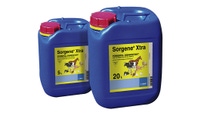BASF Professional & Specialty Solutions
Prevent unnecessary calf losses this winter with increased hygiene levels
Winter calving can present farmers with a host of environmental challenges, with colder temperatures threatening the survival of weaker animals, the increased risk of disease, and reduced daylight hours.
As we approach winter, farmers should look to increase levels of hygiene in cattle enclosures and calving equipment to prevent these losses, advises BASF’s Country Business Manager for Professional and Specialist Solutions, Laurence Barnard:
“A focus on hygiene is one of the simplest and most economical ways to reduce the spread of disease and promote healthy conditions throughout cattle housing. More frequent and thorough use of disinfectants is one of the easiest ways to reduce calf losses throughout the winter season,” he says.
To effectively use disinfectant in your cleaning routine, Laurence suggests the following approach:
1. Thoroughly disinfect all cattle housing and cubicles regularly. First, remove dung, straw and shaving. Soak all surfaces of the housing with a solution of detergent and leave it for fifteen to twenty minutes. Wash surfaces with clean, cold water using a pressure washer, then spray a solution of Sorgene® Xtra at a dilution of 1:100. Surfaces should be treated to the point of run off of the solution, and should remain wet for at least one hour. Once dry, restock with fresh straw and housing may be restocked immediately.
2. Before calving begins, ensure any sick cows or heifers are penned separately from the main herd. Similarly, once calving begins any animals that show signs of disease or illness should also be separated and treated accordingly, to help contain the spread of disease and reduce the risk of contaminating other cattle.
3. Bacteria, viruses and other micro-organisms are often present on clothing and boots. Those working with animals of any kind should wear clean overalls and dip boots in disinfectant to reduce the risk of introducing harmful diseases. Before entering the shed, it is also good practice to wash hands with an anti-bacterial soap, especially when examining cows or calves and assisting with calving, and always wear a fresh pair of OB sleeves.
4. Any equipment that is being used in conjunction with calving should be disinfected in a solution of Sorgene® Xtra before being used. Farmers should use a clean bucket and a solution of 1:200 of disinfectant to soak everything from suction bulbs and syringes to a calf puller and bottles. Solutions should be changed frequently to prevent the build-up of bacteria.
Disinfectants like Sorgene® Xtra can be used for general hygiene, spraying or specific disease control depending on the concentration used and application techniques.
Laurence adds: “Sorgene® Xtra is a *DEFRA-approved, broad spectrum environmental disinfectant, which contains a stabilised blend of peracetic acid and hydrogen peroxide. It is effective against viruses, bacteria, and hard to kill fungal spores.”
It can be used at 1:250 for general hygiene, and at 1:100 for specific disease control, for foot dips and vehicle spraying. What’s more, it breaks down after use and leaves no residue, so no rinsing is necessary, and all housing can be re-stocked immediately after application.”
“These simple steps and effective tools will help reduce the spread of disease that may result in unnecessary calf losses and prevent farmers suffering substantial financial losses, as well as protect their cows,” concludes Laurence.
*DEFRA approved against Foot and Mouth disease, Swine Vesicular disease, Poultry diseases and General Orders. Please refer to the product label for details.
For more information about Sorgene Xtra, please visit here
Related News
Information: Use biocide products carefully. Always read the label and product information before use.
